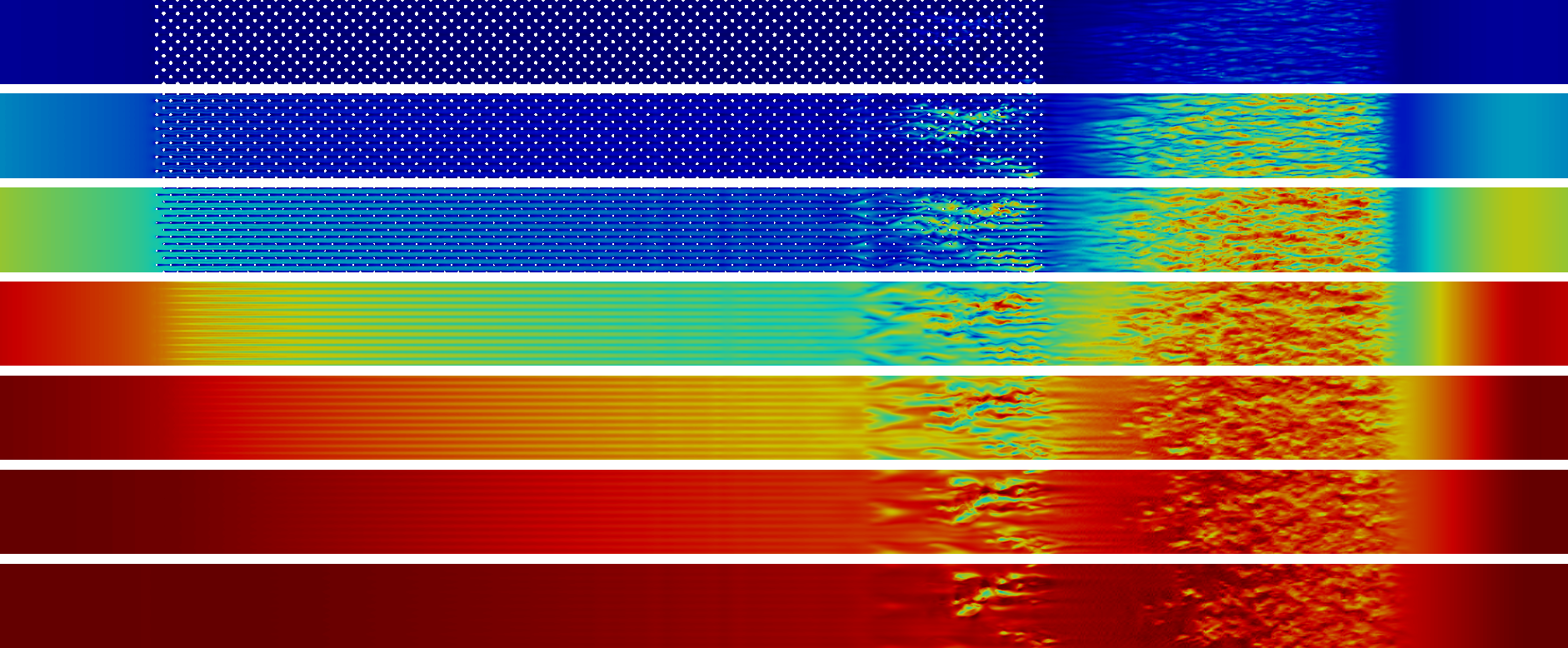For many years, we have been working on issues relating to boundary layer flows, which play a major role, for example, in the flow around gas turbine blades, vehicles, wings or rotors of wind turbines and are crucial for their function and efficiency.
In several current third-party funded projects, the mechanisms that lead to the formation and growth of turbulence patches and thus to the transition from a laminar to a turbulent boundary layer as well as the influence of turbulence and certain surface structures on the boundary layer are of particular interest. The work includes experimental investigations in the research group's wind tunnels as well as direct numerical simulations (DNS) and mathematical modeling of the processes in the boundary layer. For the experimental investigations, special measurement techniques based on hot film arrays are being developed at the ITFD, with which the spatial and temporal spread of the turbulence patches on the surface can be precisely determined. In the current MUEGRO project, we are investigating the formation and growth of turbulence patches on smooth and rough surfaces under conditions that are typical for gas turbines and aircraft engines (initial measurement results are shown in the video on this page).
The knowledge gained will be used to develop new calculation models that can be used, for example, to predict the heat transfer or friction losses on the corresponding components very accurately. The modular boundary layer code BLPro developed at the ITFD is used to develop the models. The code, programmed in Python, is linked to one of the world's largest and most comprehensive collections of test cases for boundary layer flows, so that new models can be tested and validated quickly. In the current BoLaMoTo3D project, we are linking the boundary layer code with the 3D CFD program package from NUMECA.
Contact:
Raphael Lorenz, M.Sc. (wind tunnels and metrology)
Philipp Masino, M.Sc. (mathematical modeling of transitional boundary layers)
Benjamin Sowa, M.Sc. (wind tunnels and metrology)
Prof. Dr.-Ing. Matthias Stripf (boundary layer computing method BLPro)
Florian Theobald, M.Sc. (direct numerical simulations)
Related publications
- Gramespacher C, Stripf M, Bauer H-J (2021): The Influence of Deterministic Surface Roughness and Free-Stream Turbulence on Transitional Boundary Layers : Heat Transfer Distributions and a New Transition Onset Correlation. In: Proceedings of the ASME 2021 Summer Heat Transfer Conference, 16.-18.06.2021, virtual online, https://doi.org/10.1115/HT2021-63504
- Gramespacher C, Albiez H, Stripf M, Bauer H-J (2021): The Influence of Element Thermal Conductivity, Shape, and Density on Heat Transfer in a Rough Wall Turbulent Boundary Layer with Strong Pressure Gradients. In: Journal of Turbomachinery, 10 pages, https://doi.org/10.1115/1.4050390
Auch in: Proceedings of the ASME Turbo Expo: Turbomachinery Technical Conference and Exposition, 21.– 25.09.2020, virtual online. - Mayle RE, Stripf M (2021): “I-Spots” and Emmons' Spot Production Rate. In: Journal of Turbomachinery, 143(9), 6 pages, https://doi.org/10.1115/1.4051105
Auch in: Proceedings of the ASME Turbo Expo: Turbomachinery Technical Conference and Exposition, 21.– 25.09.2020, virtual online. - Theobald F, Schäfer K, Yang J, Frohnapfel B, Stripf M, Forooghi P, Stroh A (2021): Comparison of Different Solvers and Geometry Representation Strategies for DNS of Rough Wall Channel Flow. In: Proceedings of the ECCOMAS Congress 2020 & 14 th WCCM, 11.-15.01.2021, virtual online, https://doi.org/10.23967/wccm-eccomas.2020.089
- Albiez H, Gramespacher C, Stripf M, and Bauer H-J (2019): High Resolution Measurements of Heat Transfer, Near-Wall Intermittency, and Reynolds-Stresses Along a Flat Plate Boundary Layer Undergoing Bypass Transition. In: Journal of Heat Transfer, 12 pages, https://doi.org/10.1115/1.4045756
Auch in: Proceedings of the ASME Turbo Expo: Turbomachinery Technical Conference and Exposition, Phoenix, AZ. - Gramespacher, C, Albiez, H, Stripf, M, and Bauer, H-J (2019): The generation of grid turbulence with continuously adjustable intensity and length scales. In: Experiments in Fluids, Vol. 60, https://doi.org/10.1007/s00348-019-2727-0
- Forooghi, P, Stripf, M, and Frohnapfel, B (2018): A systematic study of turbulent heat transfer over rough walls. In: International Journal of Heat and Mass Transfer, Vol. 127, pp. 1157-1168, https://doi.org/10.1016/j.ijheatmasstransfer.2018.08.013
- Albiez, H, Gramespacher, C, and Stripf, M (2018): Experimentelle Untersuchungen zur laminar-turbulenten Bypass-Transition. In: Forschung aktuell, pp. 38-42.
- Theobald, F, and Stripf, M. (2018): Direkte Numerische Simulation einer inkompressiblen turbulenten Kanalströmung mit Rauheitselementen und gekoppeltem Wärmeübergang. In: Forschung aktuell, pp. 43-47
- Kraft, O, and Stripf, M (2017): OptiSorp: Entwicklung von Adsorber-Compounds hoher Leistungsdichte für mobile und stationäre Adsorptionswärmepumpen - Experimentelle Untersuchungen und Entwicklung eines Simulationsmodells. Abschlussbericht zum FHprofUnt-Projekt, https://doi.org/10.2314/GBV:1024755177
- Albiez, H, and Stripf, M (2017): Development of Transition Models for 3D-CFD in Consideration of Turbulent Length Scales and Surface Roughness : A Sneak Preview on Projekt TRAM3D. NUMECA User Meeting, 25.-26.04.2017, Nürnberg.
- Boyle, RJ, and Stripf, M (2009): Simplified Approach to Predicting Rough Surface Transition. In: Journal of Turbomachinery, Vol. 131(4), pp. 11, https://doi.org/10.1115/1.3072521
- Stripf, M, Schulz, A, Bauer, H-J, and Wittig, S (2009): Extended Models for Transitional Rough Wall Boundary Layers with Heat Transfer : Part I: Model Formulations. In: Journal of Turbomachinery, Vol. 131(3), https://doi.org/10.1115/1.2992511
- Stripf, M, Schulz, A, Bauer, H-J, and Wittig, S (2009): Extended Models for Transitional Rough Wall Boundary Layers with Heat Transfer : Part II: Model Validation and Benchmarking. In: Journal of Turbomachinery, Vol. 131(3), https://doi.org/10.1115/1.2992512
- Stripf, M, Schulz, A, and Bauer, H-J (2008): Modeling of Rough Wall Boundary Layer Transition and Heat Transfer on Turbine Airfoils. In: Journal of Turbomachinery, Vol. 130(2), https://doi.org/10.1115/1.2750675
- Lorenz, M, Stripf, M, Schulz, A, and Bauer, H-J (2008): External Heat Transfer Measurements on a Turbine Airfoil in a Linear Cascade. In: Proceedings of the 19th International Symposium on Transport Phenomena, 17.-20.08.2008, Reykjavik.
- Stripf, M, Schulz, A, and Bauer, H-J (2007): Surface Roughness and Secondary Flow Effects on External Heat Transfer of a HP Turbine Vane. In: Journal of Propulsion and Power, Vol. 23(2), pp. 283-291, https://doi.org/10.2514/1.23062
- Stripf, M, Schulz, A, and Wittig, S (2005): Surface Roughness Effects on External Heat Transfer of a HP Turbine Vane. In: Journal of Turbomachinery, Vol. 127, pp. 200-208, https://doi.org/10.1115/1.1811101
